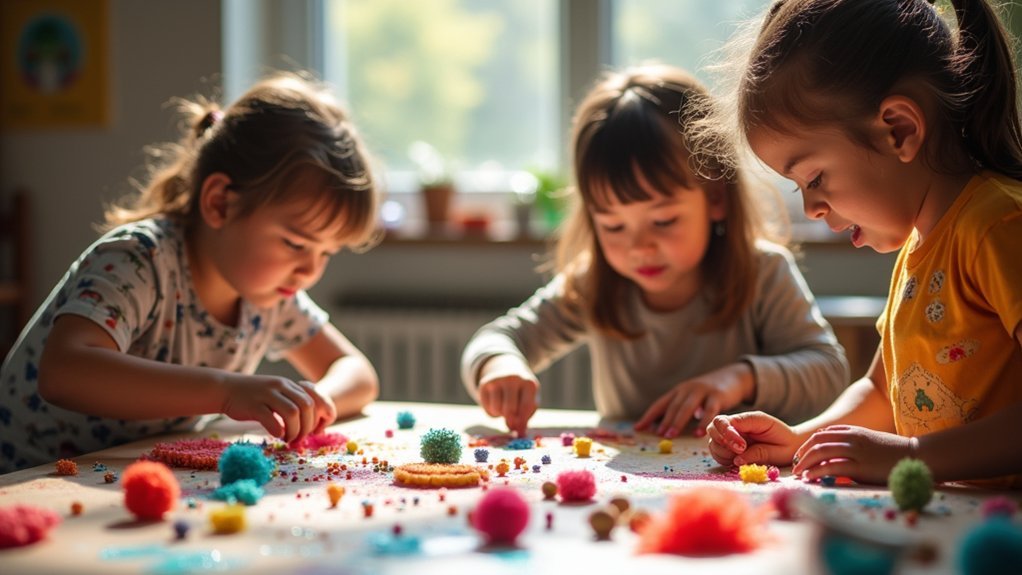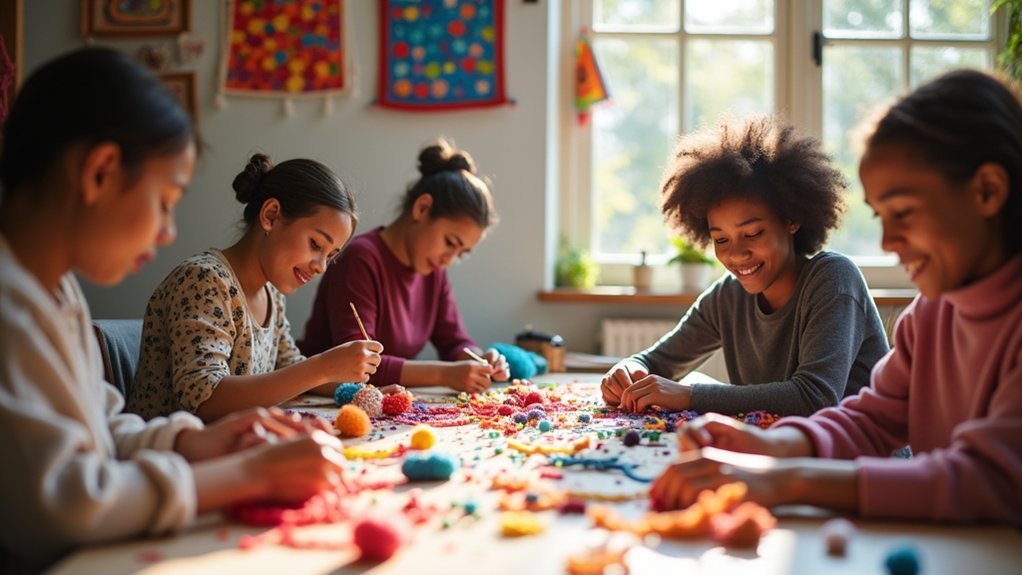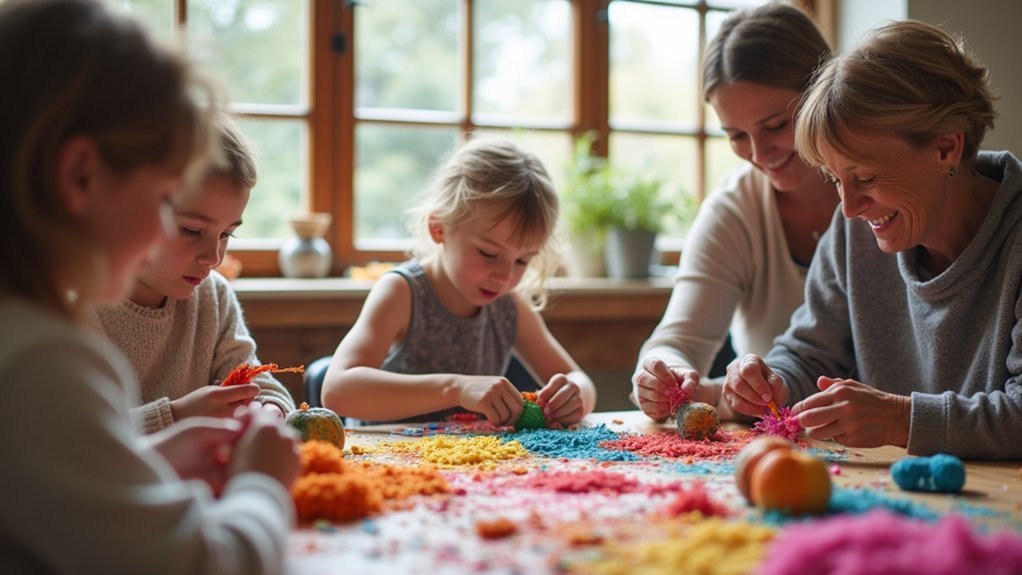Craft projects help individuals with cognitive disabilities thrive by engaging multiple brain regions simultaneously. You’ll activate visual, tactile, and procedural pathways that enhance focus and problem-solving skills. These activities promote neuroplasticity, reduce isolation, and build confidence through achievable goals. When adapted with accessible tools and supportive environments, crafting fosters independence and social connection. The cognitive benefits are substantial—research shows social creative activities can reduce cognitive decline risk by up to 55%. Discover how the right creative approach transforms challenges into opportunities.
Multi-Sensory Craft Engagement for Enhanced Brain Function

When individuals with cognitive disabilities engage in multi-sensory craft activities, they activate diverse brain regions simultaneously, creating a powerful cognitive workout. Your brain thrives on the integration of visual, auditory, and tactile experiences that crafting naturally provides.
As you guide someone with a disability through painting or sculpting, you’re helping their brain form new neural connections. This process, known as neuroplasticity, can greatly slow cognitive decline while improving focus and attention span.
The structured yet creative environment of multi-sensory craft engagement offers a perfect balance for developing minds.
You’ll notice improvements in fine motor skills and hand-eye coordination as participants touch different textures, manipulate tools, and create something meaningful. These activities don’t just stimulate cognitive processes—they build confidence and provide emotional regulation benefits too.
Adaptive Art Tools That Promote Independent Creation
Because independence in creation builds both confidence and cognitive skills, adaptive art tools have become essential for individuals with cognitive disabilities. When you provide children with disabilities the right tools, you’re releasing their creative potential and supporting their cognitive development.
- Ergonomic options like oversized grips and textured paper enhance tactile engagement while making art creation physically accessible for those with fine motor challenges.
- Technology-based solutions such as voice-activated digital art programs remove physical barriers for limited mobility users.
- Specialized environments featuring adjustable easels and supportive seating promote longer, more focused creative sessions.
These adaptive art tools, combined with simplified instructions and visual aids, help transform frustration into accomplishment, allowing individuals to express themselves confidently while developing important cognitive functions.
Social Connection Through Collaborative Craft Projects

You’ll discover that collaborative crafting offers more than just creative engagement for those with cognitive disabilities—it builds meaningful relationships through shared accomplishments.
When participants work side-by-side on group projects, they naturally develop bonds while exchanging ideas and celebrating collective achievements.
These social connections provide critical emotional support while simultaneously improving communication skills and reducing the risk of cognitive decline by up to 55%.
Crafting Builds Relationships
While many therapeutic approaches focus on individual outcomes, collaborative craft projects offer a unique pathway to social connection for people with cognitive disabilities. Engaging in craft activities strengthens bonds through shared experiences, reducing isolation and fostering a sense of community.
Research shows social interactions during crafting can reduce the risk of mild cognitive impairment by an impressive 55%.
When you incorporate group crafting into treatment plans, you’ll see:
- Enhanced communication skills as participants naturally share ideas and express preferences
- Stronger emotional connections through mutual creative accomplishments
- Increased sense of belonging as everyone contributes to a collective project
These collaborative environments create safe spaces where individuals can practice social skills and develop meaningful relationships, transforming the crafting table into a foundation for lasting connections.
Group Art Strengthens Bonds
The magic of collaborative craft projects extends beyond individual therapeutic benefits to create powerful social ecosystems for people with cognitive disabilities.
When you introduce group art activities into therapeutic settings, you’re building vital bridges of communication and connection. Engaging in creative activities together enables individuals to express themselves while forming meaningful relationships with peers and caregivers.
Research confirms these social interactions greatly reduce isolation while improving communication skills and emotional expression—essential developments for those with cognitive challenges.
You’ll notice participants gain confidence and self-esteem as they receive recognition from others in the group.
Beyond immediate social benefits, these collaborative experiences offer long-term cognitive protection, as studies show regular social engagement through art can actually decrease the risk of cognitive decline.
Tailoring Creative Activities to Different Learning Styles
Creating effective craft projects for individuals with cognitive disabilities requires recognizing and adapting to their unique learning styles.
Thoughtful adaptation to diverse learning styles unlocks creative potential in those with cognitive challenges.
When you understand whether children learn best through visual, auditory, or kinesthetic approaches, you’ll see their skills develop more rapidly during creative activities.
- Visual learners thrive with diagram-based projects and colorful collages that provide clear visual instructions they can follow independently.
- Auditory learners connect deeply with craft activities that incorporate music, verbal instructions, and opportunities to discuss their creative process.
- Kinesthetic learners excel when handling clay, wood, and textiles that allow them to physically engage with materials.
Therapeutic Benefits of Hands-On Artistic Expression

Numerous scientific studies confirm that hands-on artistic expression serves as powerful therapy for individuals with cognitive disabilities.
When you engage in craft projects, you’re developing essential planning and problem-solving skills that strengthen critical thinking abilities. Research shows participation in artistic activities can reduce the risk of mild cognitive impairment by an impressive 73%.
Beyond cognitive enhancement, crafting offers an emotional outlet for feelings that might be difficult to verbalize. This creative expression can reduce anxiety and improve emotional regulation without requiring words.
You’ll also notice improvements in fine motor skills and hand-eye coordination through regular crafting sessions. Additionally, the social nature of many craft activities cultivates communication skills and boosts self-esteem through collaborative creative experiences, making crafting a holistic therapeutic approach.
Building Self-Confidence Through Achievable Craft Goals
When individuals with cognitive disabilities complete manageable craft projects, they experience a powerful sense of achievement that directly builds self-confidence.
You’ll notice improved self-esteem as arts and crafts activities provide opportunities for expression and mastery. Crafting develops fine motor skills, enhancing dexterity and fostering independence that strengthens self-efficacy.
- Set up simple projects with clear endpoints, allowing for the satisfaction of completion and positive reinforcement from caregivers.
- Incorporate personalized elements that encourage self-expression, helping to develop stronger identity and self-worth.
- Create a supportive environment where mistakes are viewed as learning opportunities, reducing anxiety while building confidence.
The visible progress in craft projects offers tangible evidence of capability, making creative activities particularly effective for building self-confidence in those with cognitive disabilities.
Creating Memory-Supporting Craft Environments
Well-designed craft environments can greatly enhance memory retention and cognitive function for individuals with cognitive disabilities.
When helping children engage in artistic activities, guarantee your space is well-lit and organized, allowing them to locate materials independently. This organization supports memory pathways while fostering autonomy.
Incorporate familiar tools and supplies to build confidence and reduce frustration. Non-toxic materials are vital, especially for those with motor skill challenges who may need tactile exploration.
Provide ample time for projects, allowing participants to work at their own pace. This reduces anxiety and supports cognitive processing.
Consider group settings when appropriate—these not only stimulate cognitive engagement but also develop key social skills through collaborative artistic activities.
Frequently Asked Questions
What Are the Cognitive Benefits of Crafting?
Crafting boosts your planning, problem-solving, and decision-making skills. You’ll experience improved memory and attention to detail. When you’re crafting regularly, you’re reducing your risk of cognitive decline by engaging both mind and body.
How Do Arts and Crafts Help Cognitive Development?
Arts and crafts help your cognitive development by stimulating critical thinking, enhancing memory, developing executive functions, improving fine motor skills, and potentially reducing your risk of cognitive impairment. They’re truly a workout for your brain.
Why Are Arts and Crafts Good for Dementia Patients?
Arts and crafts help dementia patients because they’ll allow you to express yourself without words, reduce your anxiety, preserve your cognitive functions, potentially slow memory decline, and encourage social interaction that fights isolation.
How Does Crafting Help Mental Health?
Crafting helps your mental health by engaging your brain in critical thinking and problem-solving. You’ll experience reduced anxiety, improved emotional expression, and increased socialization—all while creating something meaningful that boosts your self-esteem and cognitive function.
In Summary
When you engage in craft activities, you’re offering a powerful therapeutic gateway for cognitive growth. You’ll see remarkable improvements as you provide adaptive tools and collaborative opportunities tailored to individual needs. Don’t underestimate the value of these creative endeavors—they build confidence, strengthen neural pathways, and foster social connections. By integrating crafts into daily routines, you’re creating meaningful pathways for cognitive development and emotional well-being.





Leave a Reply